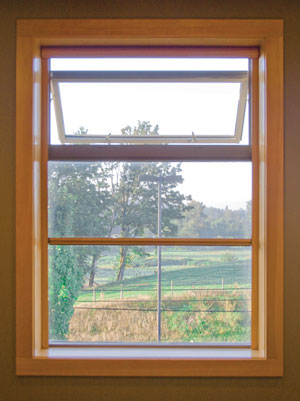Comfort on Demand
The Basics of Retractable Screens
Screens can be retracted manually or they can be motorized. Smaller manually operated screens can be good solutions in commercial projects where there is a need for insect protection. In the case of ventilating windows and egress doors, manually operated retractable screens can generally be used.
Retractable window screens should have a mesh retention system built into the vertical track so that mild winds will not blow the mesh out of the track. On a door, mesh retention systems are not as important as the horizontal track length is generally not as long; however, in areas of high wind this should be discussed with the manufacturer as door systems with options for mesh retention are available.
There are various retraction methods available now for manually operated insect screens:
- constant tension coil springs which are typically constructed of steel and then coated with a waterproof lubricant to prevent rusting. The springs are enclosed for further protection from corroding particles. Stainless steel is also used but may not be as strong and durable.
- counterbalance weight systems where the weight is used to self-retract; and
- non-self retracting systems that need manual assistance; it will not retract on its own.
Motorized retractable screens, which should be certified to conform to UL Standard 325 for the US and certified to CSA Standard C22.2 No. 247 for Canada, offer sleek-cost-effective solutions to shading the glass facades of today's buildings. The mesh is held tightly into the track on both sides with a zipper system to prevent blowout. There should be a seal at the bottom of the slide bar when it's also being used for insect protection. There is often a brush system at the top for cleaning the mesh as it retracts onto the roller, and also to prevent bugs from entering at the top.
 |
Manually retractable screens can be used in ventilating windows and egress doors. Photo courtesy of Phantom Screens |
These screens operate vertically and instead of using tension springs, an electric motor is used usually drawing 120 Volts and up to 2.1 amps at full load. The radio frequency motors draw a nominal amount of energy when in stand-by.
The motor powers the screen up. For lowering, the motor releases the mesh at a controlled rate and a weighted slide bar attached to the end of the mesh gives the gravitational force necessary to pull the mesh down. It is not being forcibly driven down like a garage door.
Operating Systems for Solar Tracking
Motorized retractable screens are typically operated through radio frequency remote. Controls can be as simple as a hand-held remote control or incorporated into a building automation system. If an automation system is selected, multiple screens can be made to operate independently of each other, or simultaneously in virtually any combination of groupings. Environmental sensors are available that automate the function of the screens with typical triggers being solar intensity and/or wind. This allows optimum performance based on environmental conditions vis a vis the building location and orientation.
A sun sensor is available that is equipped with a solar panel that recharges the batteries contained in the unit. It is about the size of a hockey puck and can be easily placed and moved around the building. Individual controls are available so that the building automation system settings can be over-ridden.
Controlling Light and Solar Heat Gain
Fenestration is an important and highly desired part of any building - but its role in a structure's heat gain needs to be clearly understood. Proper sizing, orientation and location of windows must all be carefully considered in controlling heat gain, but even so, other types of shading protection are often necessary. Interior shading devices like blinds or vertical louvers can provide glare control and they do provide immediate personal controls to regulate heat and light; however, interior blinds can interfere with furniture layouts and operations, attract dust and, unless mechanized, their performance will not maximize cooling load reduction. Preventing solar heat gain from coming through the window in the first place by using an exterior mounted screen offers an alternative solution on many levels.
Exterior shade systems - including overhangs, louvers, light shelves, awnings, fins and screens - are considered to be more effective than interior systems in blocking solar heat gain. Because retractable screens and other external devices can be mounted on the window exterior, they absorb and dissipate the sun's heat and glare before it even reaches the glazing.
A study commissioned by the Professional Awning Manufacturers Association and conducted by the Center for Sustainable Building Research at University of Minnesota showed that stopping solar rays before they reach the room, at the exterior of the building, reduces the heat buildup between 65 percent and 77 percent. The U.S. Department of Housing and Urban Development calls any way that stops the sun before it gets through the glass "seven times as good at keeping the interior cool as blinds or curtains on the inside." While interior shades cut the intensity and heat of direct sunlight, even a light-colored interior shade reduces solar heat gain by about one-third to one-half of the incident solar energy, while an exterior shade can reduce 80 percent of the incident solar energy. ("Daylighting Design in Libraries," Edward T. Dean, AIA, 2005)









